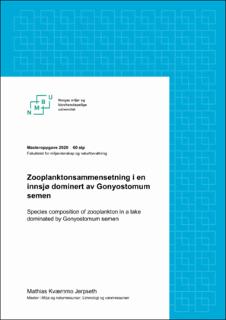| dc.contributor.advisor | Rohrlack, Thomas | |
| dc.contributor.advisor | Riise, Gunnhild | |
| dc.contributor.author | Jerpseth, Mathias Kværnmo | |
| dc.coverage.spatial | Norway | en_US |
| dc.date.accessioned | 2020-08-20T10:56:38Z | |
| dc.date.available | 2020-08-20T10:56:38Z | |
| dc.date.issued | 2020 | |
| dc.identifier.uri | https://hdl.handle.net/11250/2673181 | |
| dc.description.abstract | Gonyostomum semen er en encellet nåleflagellat, og oppleves som invasiv i Norge. Utbredelsen har økt de siste tiårene, spesielt i humøse innsjøer. G. semen har egenskapen til å migrere ned til hypolimnion for å ta opp næringsstoffer, og opp til eufotisk sone for å drive fotosyntese. Noen få arter av zooplankton, som Daphnia magna og Eudiaptomus gracilis, har vist å innta G. semen under laboratorieforsøk, men beitepress fra zooplankton har ikke vist å forhindre oppblomstringer av algen i sitt naturlige miljø. Der algen danner oppblomstringer blir det færre spiselige fytoplankton-arter, hvilket gir et begrenset næringsgrunnlag for zooplankton. Dette har tidligere vist å selektere mindre, bakteriespisende cladocera som Ceriodaphnia quadrangula og Bosmina longispina. Chaoborus flavicans, en predatorisk svevemygg-larve, fremstår også som vanlig i G. semen-vann.
I dette studiet ble G. semen og artssammensetningen av zooplankton overvåket gjennom sesongen 2019. Prøvetakinger ble gjort hver andre uke i vannet Brønnerødtjern i SørøstNorge. Vannet er lite og grunt med svært høye DOC-verdier. Det ble funnet C. quadrangula, B. longispina, C. flavicans, Leptodora kindtii, nauplius, calanoide og cyclopoide copepoder. Det ble ikke funnet noen arter av Daphnia, men sannsynligheten for at Daphnia har vært i
Brønnerødtjern tidligere er stor. Zooplankton-sammensetningen antas derfor å ha vært gjennom et skifte, hvor dagens sammensetning domineres av mindre og bakteriespisende arter. Da G. semen ble påvist i vannet ble veksten hos alle registrerte zooplankton redusert, utenom hos nauplius. Bestanden av C. quadrangula steg igjen da G. semen-oppblomstringen kollapset, hvilket foreslår at en begrenset del av næringsstoffene fra algen kan bli anvendt av enkelte zooplankton-arter, som C. quadrangula. C. quadrangula benytter trolig næringsstoffene fra G. semen indirekte via bakteriene og organismene i den mikrobielle loopen, som livnærer seg av å bryte ned G. semen når algen dør. Reduksjonen i veksten til zooplanktonet registrert i dette studiet indikerer at G. semen er en blindvei i næringsnettet for høyere trofiske nivåer. | en_US |
| dc.description.abstract | Gonyostomum semen is a unicellular Raphidophyte which is considered invasive in Norway. The geographical spread of the algae has increased the last decades, especially in humic lakes. G. semen has the ability to migrate down to the hypolimnion where it utilizes the abundance of nutrients, and up to the euphotic zone for photosynthesis. A few species of zooplankton, like Daphnia magna and Eudiaptomus gracilis, have shown to ingest G. semen during laboratory experiments, but there are no known observations of grazing preventing blooms in the algae’s natural habitat. During G. semen blooms there are fewer edible phytoplankton species, which limits the variety of food for zooplankton in general. This has earlier shown a selection towards smaller, bacterivorous cladocera like Ceriodaphnia quadrangula and Bosmina longispina. The predatory phantom midge larva Chaoborus flavicans also appears as common in G. semen lakes.
In this study G. semen and zooplankton species composition were monitored throughout the growth season of 2019. Samples were taken every other week in the water Brønnerødtjern south-east in Norway. The water is relatively small and shallow with very high concentrations of DOC. The zooplankton composition consisted of C. quadrangula, B. longispina, C. flavicans, Leptodora kindtii, nauplius, calanoid and cyclopoid copepods. No Daphnia was registered, but its very likely that Daphnia was present in earlier years. The composition of zooplankton has therefore presumably been through a shift, where todays composition consists of small, bacterivorous species. When G. semen was detected later in the growing season the growth of all the registered zooplankton decreased, except of nauplius. The population of C. quadrangula later increased when the G. semen-bloom collapsed, which creates the notion that G. semen indirectly supports growth of some zooplankton species, like C. quadrangula. The nutrients from G. semen probably reaches C. quadrangula through bacteria and the microorganisms in the microbial loop, which increase in biomass when the algae die. The reduction in zooplankton biomass production in this study indicates that G. semen is a dead end for higher trophic levels in the wood web where the algae occurs. | en_US |
| dc.language.iso | nob | en_US |
| dc.publisher | Norwegian University of Life Sciences, Ås | en_US |
| dc.rights | Attribution-NonCommercial-NoDerivatives 4.0 Internasjonal | * |
| dc.rights.uri | http://creativecommons.org/licenses/by-nc-nd/4.0/deed.no | * |
| dc.subject | Gonyostomum | en_US |
| dc.subject | Zooplankton | en_US |
| dc.subject | DOC | en_US |
| dc.subject | Ferskvann | en_US |
| dc.subject | Økologi | en_US |
| dc.title | Zooplanktonsammensetning i en innsjø dominert av Gonyostomum semen | en_US |
| dc.title.alternative | Species composition of zooplankton in a lake dominated by Gonyostomum semen | en_US |
| dc.type | Master thesis | en_US |
| dc.description.version | submittedVersion | en_US |
| dc.subject.nsi | VDP::Matematikk og Naturvitenskap: 400 | en_US |
| dc.source.pagenumber | 31 | en_US |
| dc.description.localcode | M-MINA | en_US |

